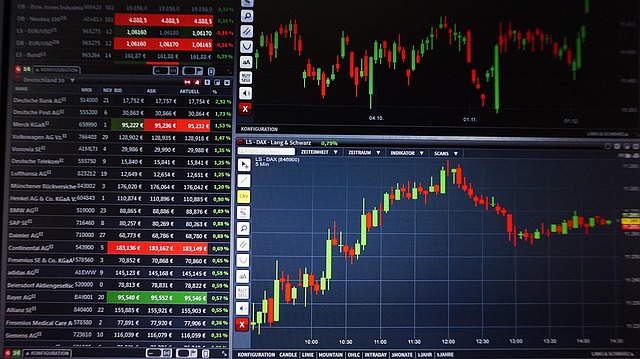Are There Fees for Trading Stocks?
Author: Jameson Richman Expert
Published On: 2025-08-14
Prepared by Jameson Richman and our team of experts with over a decade of experience in cryptocurrency and digital asset analysis. Learn more about us.
Understanding whether trading stocks incurs fees is fundamental to crafting an effective and sustainable investment strategy. As the stock trading landscape has evolved rapidly—particularly with the proliferation of online brokerage platforms—the perception that the stock market is a low-cost or even free activity has gained widespread acceptance. However, beneath this seemingly straightforward surface lie numerous hidden or less obvious charges that can significantly erode your returns over time. Recognizing and thoroughly understanding these costs enables investors to select suitable trading platforms, develop cost-efficient strategies, and maximize profitability in both the short and long term. This comprehensive analysis explores the various fees involved in stock trading, how brokers structure these charges, and proven methods to minimize trading expenses. Drawing parallels with the burgeoning cryptocurrency trading sphere—where fee transparency is often higher—we can extract valuable insights applicable across markets. Whether you're a novice investor or a seasoned trader, being well-informed about trading fees is essential for developing sustainable, profitable trading practices.

What Are the Common Fees Associated With Stock Trading?
Stock trading fees encompass a broad spectrum of direct and indirect costs. A thorough understanding of these charges helps traders evaluate platforms more effectively, avoid unpleasant surprises, and preserve gains. The most prevalent fees include brokerage commissions, spreads, account maintenance fees, and other miscellaneous charges. These costs can vary greatly depending on the broker’s fee structure, trading volume, account type, and the securities traded. Being aware of these differences allows traders to develop strategies that mitigate unnecessary expenses and enhance overall return profiles.
Brokerage Commissions
Brokerage commissions are among the most recognizable trading fees. Historically, full-service brokerage firms charged substantial commissions—sometimes hundreds of dollars per trade—reflecting personalized advisory services, extensive research, and tailored portfolio management. However, the advent of online discount brokers has revolutionized this model, drastically lowering or eliminating these fees. Many now offer zero-commission trades for stocks and ETFs, especially targeting retail investors. Despite this trend, some brokers impose fixed or variable commissions for specific asset classes, international trades, or specialized services. For example, traditional brokers like E*TRADE, Charles Schwab, and TD Ameritrade typically offer commission-free equity trades but may charge for options trading, futures, or Forex transactions. High-volume or professional traders often benefit from tiered fee structures provided by platforms like Interactive Brokers, which reward frequent traders with lower per-trade costs. It’s essential to scrutinize the fine print—some “free” trades are subsidized via wider spreads or account fees, so overall costs can still be substantial. Additionally, certain brokers may impose minimum trade charges or inactivity fees, which can accumulate if trading activity is infrequent or inconsistent.
Spread Costs
The bid-ask spread—the difference between the highest price a buyer is willing to pay and the lowest price a seller is willing to accept—is a subtle yet significant hidden cost embedded within your trades. While stock exchanges offer transparent order books, some brokers execute trades via market makers or dark pools, which may embed spreads into their quoted prices. Wide spreads tend to increase trading costs, especially in low-liquidity or highly volatile stocks. For day traders or high-frequency traders, even minor spread variations can translate into substantial cumulative costs over multiple transactions. Cryptocurrency platforms like Binance or Bybit often embed spreads directly within their quoted prices, creating analogous costs in stock trading environments—particularly when trading less liquid securities or during periods of market stress. Awareness of spread dynamics is crucial, as they directly impact execution prices and trade profitability.
Account Maintenance and Platform Fees
Many brokers impose ongoing fees to maintain accounts or access their trading platforms. These include annual or quarterly account maintenance charges, inactivity fees (if no trades occur over a defined period), or platform-specific usage charges. Full-service brokers tend to have higher account fees but often compensate with valuable research tools, advisory services, and dedicated support. Conversely, newer digital platforms such as Robinhood, MERRILL Edge, and Webull often waive these fees to attract retail clients. High-net-worth or professional traders can sometimes negotiate lower fees or secure access to premium features—such as advanced charting tools, direct market access, or personalized support—that offset costs, but this typically requires meeting specific account or trading volume thresholds.
Additional Costs
Beyond primary fees, traders should account for ancillary expenses that can subtly erode gains. These include charges for real-time data feeds, margin interest on borrowed funds, withdrawal or transfer fees, and account transfer costs. Margin trading amplifies buying power but incurs interest costs that can eat into net gains if not managed carefully. Withdrawal fees vary among brokers—some offer free transfers, while others impose charges on outgoing funds—potentially adding up if frequent transfers are part of your strategy. Currency conversion fees may also apply when trading international securities or dealing in foreign currencies. Recognizing these miscellaneous costs is vital for comprehensive expense management, particularly for active traders or those with international portfolios.
How Do Different Brokers Charge Trading Fees?
Brokerage fee structures are tailored to different customer segments and trading needs. Discount brokers such as Robinhood, Webull, and Charles Schwab often promote zero-commission trading, making stock market participation more accessible and affordable. However, they may offset costs through alternative revenue streams like payment for order flow (PFOF), wider spreads, or premium account features. For instance, Robinhood’s PFOF arrangements involve routing orders to third-party market makers in exchange for compensation, which can raise concerns about trade execution quality and transparency. On the other hand, specialized platforms like Interactive Brokers, Tradestation, or Fidelity serve active traders and institutional clients with tiered fee structures that reward higher trading volumes with lower per-trade costs and more advanced tools. Cryptocurrency derivatives platforms like Binance or Bybit also have their own fee models based on trading volume, asset types, and membership tiers—these models can serve as useful benchmarks for stock traders seeking similar cost efficiencies in traditional markets. Comparing these structures helps investors identify the most cost-effective options aligned with their trading styles.
Strategies to Minimize Stock Trading Fees
Reducing trading costs is both possible and advisable through strategic planning and careful platform selection:
- Choose No-Commission Platforms: The rise of zero-commission brokers like Robinhood, Webull, and Charles Schwab has democratized access to stock trading. They often generate revenue via PFOF, wider spreads, or premium features, so understanding these trade-offs is key.
- Leverage Promotions and Incentives: Many brokers offer sign-up bonuses, promotional trading periods with discounted spreads, or reduced commission rates for new clients. Similar to crypto exchanges that attract traders with deposit bonuses, stock brokers often provide incentives that reduce initial costs.
- Trade Larger, Less Frequently: Executing fewer, larger trades minimizes transaction costs—especially spreads and commissions—aligning with buy-and-hold or swing trading strategies that focus on long-term gains.
- Use Fee-Optimized Account Types: High-net-worth individuals or active traders can negotiate lower fees or gain access to premium features like direct market access, which reduces costs associated with market impact and order execution.
- Implement Limit Orders: Placing limit orders helps control execution prices and avoid the wider spreads associated with market orders, particularly in volatile markets. Over time, this approach reduces trading costs and improves net returns.
- Automate and Plan Trades: Utilizing algorithmic trading tools and pre-planned strategies helps prevent impulsive, expensive trades, ensuring each transaction is purpose-driven and cost-efficient. Automation can also help execute trades during favorable market conditions for spreads and liquidity.

The Impact of Fees on Long-Term Trading Performance
Over extended periods, trading fees can markedly diminish net returns, especially for high-frequency or day traders. For example, executing 50 trades daily at $5 per trade results in $250 daily or roughly $62,500 annually—a significant expense that can surpass gains or turn otherwise profitable trades into net losses. When compounded over months and years, these costs erode wealth accumulation and investor capital. In volatile, high-cost environments like cryptocurrency markets, transaction costs—embedded within spreads or network fees—amplify this effect. Recognizing the cumulative impact of fees and actively managing them is crucial for long-term success. Strategies such as consolidating trades, trading during periods of narrow spreads, and choosing cost-efficient platforms are vital for maintaining profitability. A disciplined approach to minimizing costs can significantly improve overall investment performance.
Conclusion: Are There Fees for Trading Stocks?
While many modern brokerage platforms promote low-cost or zero-commission trading, most stock transactions involve some form of expense—whether explicit, like commissions and account fees, or implicit, such as spreads and data charges. Carefully scrutinizing a broker’s fee structure, comparing different platforms, and adopting cost-conscious trading practices are essential steps toward maximizing your investment returns. Strategies like trading larger volumes less frequently, utilizing limit orders, and leveraging promotional offers can substantially reduce overall costs. Additionally, gaining insights from the cryptocurrency market—where fee transparency often fosters competition—can inform smarter decision-making in traditional markets. By understanding and actively managing trading fees, investors can build a resilient, efficient, and profitable trading operation that sustains growth over the long haul.
Insights from cryptocurrency exchanges—such as Binance vs. Bybit fee comparison—highlight the value of transparent fee structures and competitive pricing. Applying these principles to stock trading, through diligent research and strategic planning, ensures that your investment capital works harder for you. Ultimately, fee awareness and management are not just about reducing expenses—they are about optimizing your entire trading ecosystem for sustained success.